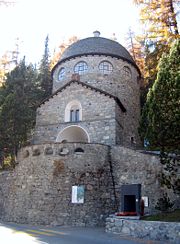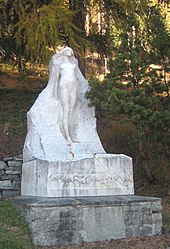Segantini Museum
The Segantini Museum in St. Moritz shows works by the painter Giovanni Segantini . It opened in the summer of 1908 and was completed in September of the same year. It was built according to plans by the architect Nicolaus Hartmann (1880–1956) as a kind of accessible monument. The building with the mighty dome is based on the pavilion that Segantini had planned for his Engadine panorama at the Paris World Exhibition of 1900 . In contrast to Segantini's original plans, Hartmann reduced the size of the building, added storeys and used local rubble stones instead of an iron structure.
Works
In addition to photographs by the artist and his family, the museum shows around fifty works from all of Segantini's creative periods. Particularly well-known are the paintings shown on permanent loan from the Otto Fischbacher Giovanni Segantini Foundation in the museum: Ave Maria bei der Überfahrt (2nd version 1886), Bündnerin am Brunnen (1887), Early Mass (1885) and Noon in the Alps (1891)
| Pictures (selection) | |||||
|---|---|---|---|---|---|
Segantini's main work, the “Alpine Triptych”, is on display in the large domed hall on the upper floor. The lighting comes from several skylights, which make the colors of the work appear different depending on the time of day and the incidence of light. Werden shows the evening meadow at Soglio , Sein shows the broad view from Schafberg and Vergehen shows the snowy landscape of Maloja before sunrise. The middle section of Sein reminds of the geographical connection between the museum and Segantini's death hut. The Segantini Museum was built at the point “between the dark mountain horizon and Lake St. Moritz, where the lines of the infinite radiant sky would meet.” A bust of Segantini by Paolo Troubetzkoy is also on display .
| The alpine triptych | |||||
|---|---|---|---|---|---|
history
In 1907 the friend and doctor Giovanni Segantinis, Dr. Oskar Bernhard , returned from a trip to southern Italy and visited Segantini's art dealer Alberto Grubicy in Milan. In the course of their conversation, the idea of founding a museum in St. Moritz arose. He submitted the project to a group of friends who formed a “Comitatio per il Museo Segantini”. Three guidelines for the construction of the museum were laid down: The main axis of the museum should be directed to the east towards Segantini's death hut on the Schafberg; the building should be picturesquely integrated into the mountainside and stand out as a monument; the building was intended to echo the pavilion designed by Segantini for the Paris World Exhibition in 1900.
The negotiations led to a contract between the Milanese art dealer Grubicy and St. Moritz Bank AG. It was agreed that the bank would grant a loan of 300,000 Swiss francs. As a guarantee, the dealer deposited a number of pictures and drawings by Segantini, which should form the basis of the museum. This number of works was set at a value of 750,000 francs and Grubicy undertook to leave them to the museum within three years.
On the ninth anniversary of Segantini's death, on September 28, 1908, the museum was inaugurated and opened in June 1909 and handed over to the municipality of St. Moritz. In his address, Oskar Bernhard stated that the museum did not have any pictures of its own, as these were deposits from the “Galleria Vittore ed Alberto Grubicy”, which, according to the contract, are made available to the museum for three years. If the funds to purchase the works, estimated at CHF 750,000, were not raised, the gallery would have the option of selling the pictures elsewhere.
The "Comitatio per il Museo Segantini" had to act quickly if it wanted to prevent the resale of the works and turned to the federal government and the Gottfried Keller Foundation . Another contract was signed with Grubicy in July 1911, according to which the triptych , without the middle piece being , was to become the property of the museum for a value of 475,000 francs. The center piece, which Gubicy had sold to Prince Wagram in Paris for 160,000 lire in 1906, was brought together again through an agreement with him.
The financing came with the help of the “Gottfried Keller Foundation”, which took over the amount of 250,000 francs on the condition that the “Comitatio per il Museo Segantini” raised an amount of 225,000 francs based on a payment plan was advanced to the committee by the Federal Finance Administration.
The outbreak of the First World War prevented the “Comitatio per il Museo Segantini” from fulfilling its obligations to the financial administration. The last installment could not be paid until 1928 instead of the planned 1923. The triptych and the collection were now finally in the museum's possession.
The construction
In keeping with Alpine tastes, the museum is modest and rather strict. It has a diameter of 12.5 m and was inserted into the steep forest slope. The walls are made of local quarry stone, the roof is covered with local Malenco stone slabs. In 1981 the first structural change was made, in which a hall was added to the rear of the museum, not visible from the front, in order to be able to properly present the collection, which has since grown considerably.
In front of the museum is a marble sculpture by the Italian sculptor Leonardo Bistolfi . It was created around 1904 and bears the inscription: La bellezza liberata dalla materia - a Giovanni Segantini (Beauty freed from matter - for Giovanni Segantini). It was originally intended for Segantini's grave in Maloja.
literature
- Comitatio Segantini St. Moritz (Ed.): Giovanni Segantini and the Segantini Museum in St. Moritz. Engadin Press AG, Samedan 1968.
- Daniela Tobler, Guido Magnaguagno (Eds.): Giovanni Segantini. 1858-1899. Kunsthaus Zürich, Zürich 1990, (exhibition catalog, November 9, 1990 to February 3, 1991).
- Reto Bonifazi: Segantini. A life in pictures. Werd-Verlag u. a., Zurich 1999, ISBN 3-85932-280-X .
- Dora Lardelli: The Segantini Museum in St. Moritz. (Swiss Art Guide, No. 480). Ed. Society for Swiss Art History GSK. Bern 1994, ISBN 978-3-85782-480-7 .
Web links
swell
- ^ Website of the Segantini Museum
- ^ Dora Lardelli: The Segantini Museum in St. Moritz. Exhibition building - memorial - panorama pavilion , in: Giovanni Segantini. 1858-1899 , Kunsthaus Zürich 1990, p. 213 f.
- ^ Gottardo Segantini: 25 Years Segantini Museum , St. Moritz 1933, pp. 56, 59
- ^ Dora Lardelli in: Kunsthaus Zürich 1990, p. 219









